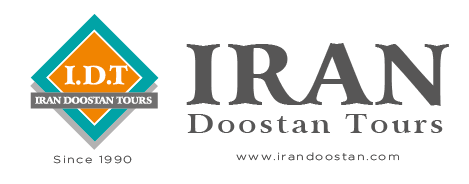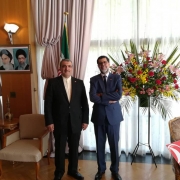Travel to Iran would probably be like none of your previous trips, it is certainly a unique destination you never expect. There are loads of unique experiences waiting for you here, including cultural attractions, natural beauty, warm-hearted hospitable people, and tasty local foods.
Well, the next issue might be your safety. While you are searching is it safe to travel to Iran, it is never easy to distinguish between propaganda and genuine information. The two risk assessment institutions “International SOS” and “Risk control” evaluate Iran’s risk to travelers to be comparable to that of most European countries’.
Iran Doostan Tours Co. is a reliable Iran travel agency for incoming tours to Iran. No difference whether you are aiming to travel to Iran from Canada or travel to Iran from India, or any other country, we are honored to offer high-quality services in terms of diverse package tours. As a tour operator and travel agency in Iran, we provide all travel services including itineraries, visa, tour guides, transportation, accommodation, and whatever our tourists may need while traveling to Iran. If you are looking for some self-drive tours like travel to Iran by car, we are also ready to provide you with all you may need.
It is good to know that the Iran visa process is quite fast and convenient and the tourists can also apply for a visa online. However, if you intend to travel to Iran from the UK or US, your visa may take a bit longer to be issued.
If you have a call for an independent traveling to Iran, we wholeheartedly respect your decision; then all you may need to have except an Iran travel guide book and a map would be reading some tips for traveling to Iran in our Iran travel blog. For any travel to Iran experience, you are recommended to visit our guest blog and also our trip advisor page, it may be helpful. You may also like to spare some time watching interesting Iran tourism videos to whet your appetite for traveling to Iran.
Our professional colleagues are ready to help you if you have planned to travel to our country. Contact us via info@idt.ir. We will be back to you soon.
Posts
Naqsh-e Rostam Necropolis: Photos, Video, Info
Naqsh-e Rostam is an ancient necropolis situated northwest of Persepolis, the capital of the Achaemenid Empire. Naqsh-e Rustam (Naqsh-e Rostam) is an impressive reminder of the once glorious Achaemenid Persian Empire (c. 550–330 BC) and it stands as a magnificent manifestation of ancient Persian art. Naqsh-e Rostam is the house for the immense rock tombs cut high into the cliff. The rock tombs belong to four Achaemenian kings. The ancient tombs attracted Sasanian kings as well. They wished to imitate the glory of the Achaemenian kings; maybe that is why they created huge reliefs besides the tombs. The immense rock reliefs mainly depict the investiture scenes and the equestrian fights of the Sasanian kings. However, the history of Naqsh-e Rostam is not limited to the Achaemenid and Sassanid periods.
There is evidence that the site exists from the Elamite period. An ancient rock relief dating back to the Elamite period indicates that Naqsh-e Rostam had been a sacred place during ancient times. That might be the reason Darius I ordered to carve his monumental tomb into the cliff at the foot of Mt. Hosain (Huseyn Kuh). His rock tomb is famous for its two inscriptions known as the king’s autobiography. The inscriptions indicate that Darius the Great had been the king who ruled according to justice. Travel to Iran and enjoy visiting so many great cultural attractions, especially the great ones registered on UNESCO World Heritage List or waiting to be registered. Pasargadae, Persepolis, Naqsh-e Rajab lies a few hundred meters from Naqsh-e Rustam, and Naqsh-e Rustam, the ancient necropolis of the powerful Persian kings are the best cultural attractions of Iran located in Shiraz, Fars province.
Achaemenid Tombs
Naqsh-e Rostam houses four rock tombs carved out of rock faces. Since the façades of the four Achaemenian tombs look like Persian crosses- chalipa- some call them Persian Crosses as well. The entrance to each tomb is located at the center of the cross and it leads to a small chamber where the king’s body lay in a sarcophagus. It is not clear whether the bodies were directly put into the sarcophaguses or the bodies were exposed to a tower of silence, and then the bones were put there. What is certain is that the tombs were closed after the burial, but the doors were smashed and the tombs were looted after the invasion of Alexander the Great in the 4th BC.

Naqsh-e Rustam, the Ancient Necropolis of Powerful Persian Kings
The four tombs cut high into the cliff belong to Achaemenid kings; however, only one of them is explicitly identified as it is accompanied by an inscription. The tomb belongs to Darius I who was the fourth Achaemenid emperor. There is a relief above his tomb and it depicts Darius I whose hands are raised for worship, he stands on a raised three- stepped platform in front of an altar, and the winged figure of Ahuramazda (the Zoroastrian god) is also at the center of the relief. The platform is supported by 28 throne bearers representing each of the kingdoms of the Achaemenid Empire. The other three rock tombs carry no inscriptions. Since the layout of the tombs is just copied from the tomb of Darius I, it is believed that they belong to his successors Xerxes I, Artaxerxes I, and Darius II. In 1923, the German archaeologist Ernst Herzfeld made casts of the inscriptions on the tomb of Darius I. Since 1946, the casts have been in the archives of the Freer Gallery of Art and the Arthur M. Sackler Gallery in Washington, DC.

Darius I standing on a platform in front of an altar and the winged figure of Ahuramazda
Ka’ba-ye Zartosht
In front of the rock tombs, there is a square tower known as the Ka’ba-ye Zartosht which means the Cube of Zoroaster (Ka’ba is the famous monument as a holy site for Muslims located in Mecca). The structure of the building is a copy of a sister building at Pasargadae known as the Prison of Solomon; however, this building is a few decades older than Ka’ba-ye Zartosht. On the wall of the tower, there is an inscription in three languages from Sasanian time and it is considered one of the most important inscriptions of that period. It is not obvious what the purpose of the building had been. It might have been a library for the holy books, a place to keep the holy fire, or maybe a treasury.

Ka’ba-ye Zartosht in front of the rock tombs at Naqsh-e Rustam
According to Persepolis fortification tablets, there must have been trees at Necropolis that apparently refer to Naqsh-e Rostam. The experts believe that there must have been three lines of trees in the area between the tower and the tombs; however, it has been a long time since the trees disappeared.
Sassanid Reliefs
Besides the tombs, there are seven oversized stone reliefs dating from the 3rd century AD. The huge rock reliefs mainly belong to the Sassanid period and they depict scenes of imperial conquests and royal ceremonies. What is amazing about the reliefs is that they indicate details of events carved in the heart of rough rocks. Therefore, they can give the visitors a visual insight into the spirits of ancient times.
The most famous rock relief at Naqsh-e Rostam belongs to the Sasanian king Shapur I. The relief depicts his victory over two Roman emperors; Valerian and Philip the Arab. Shapur I is on the horseback, while Valerian is bowing to him and Philip the Arab is holding Shapur’s horse.

Shapur I celebrates his victory over two Roman emperors; Valerian and Philip the Arab
The investiture relief of Ardashir I as the founder of the Sassanid Empire is also depicted. The relief indicates Ohrmazd giving Ardeshir the ring of kingship. The inscription also has the oldest use of the term “Iran”.
There are also equestrian reliefs such as the equestrian relief of Hormizd II at Naghsh-e Rustam. The relief depicts Hormozid and above the relief, one would see a badly damaged relief that apparently is depicting Shapur II with his courtiers.
The relief of Bahram II depicts the king with an oversized sword. On the left, five figures stand and they seem to be the members of the king’s family. On the right, three courtiers stand and one of them is apparently Kartir- a highly prominent Zoroastrian priest.
The Oldest Relief at Naqsh-e Rostam
The oldest relief at Naqsh-e Rostam dates back to approximately 1000 BC and it dates back to the Elamite period. Though the relief is severely damaged, it depicts a faint image of a man with unusual headgear. He is thought to be an Elamite one.
Why Is It Called Naqsh-e Rostam?
Sassanid reliefs mainly depict equestrian fights or investiture scenes. Since the equestrian fights of the Sasanian kings represent the tales of chivalry, locals believed that the man depicted on reliefs was Rustam, the hero of Shahnameh. The epic of Shahnameh is the masterpiece of Ferdowsi, the great Iranian poet of the 10th and 11th the century. Therefore, the site is called Naqsh-e Rustam (meaning the carvings of Rustam); because the locals believed that the carved man on the reliefs was their epic hero” Rustam”.

Locals believed that the carved man on the reliefs was their epic hero” Rustam”
To explore the awe-inspiring ancient site of Naqsh-e Rostam, the ancient necropolis of powerful Persian kings of the Achaemenid dynasty, travel to Iran- the country of ancient civilization and diverse cultures- and enjoy visiting its fantastic tourist sites and its friendly locals.
Are you planning to travel to Iran? Check out our Iran tours.












